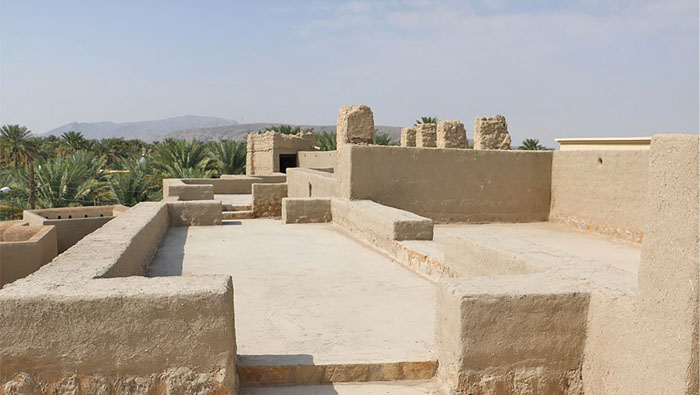
Adam: The Ministry of Heritage and Culture continues the restoration works in Adam Castle in the Wilayat of Adam in the Governorate of A’Dakhiliyah.
The Ministry is exerting great efforts to preserve features of the Omani architectural heritage with its Arab and Islamic styles, as part of its constant quest to preserve elements of the Omani heritage through its ambitious plan and approach for the restoration of mosques, castles, forts and neighbourhoods in the Sultanate.
Said bin Salim Al Jadidi, archaeologist at the Ministry of Heritage and Culture, said: “The restoration of Adam Castle began in early 2016 through several stages, the first of which was the cleaning of the site from all the wastes. The components of the castle were almost completely destroyed, especially from the north. Passages were opened to the rest of the castle’s facilities. The foundations of the castle and the surrounding walls were built after that with gravel, sand, cement and clay. The interior walls were built and date-palm trunks were used for roofing, as Omanis used them to build roofs of mosques, houses and lanes of neighbourhoods due to their thickness and durability to various conditions”.
He said that the main door of the castle and the other 12 doors of different sizes, in addition to the 13 windows of the rooms and the tower, were manufactured in the workshop of the ministry located in “Al Busaid Neighborhood Mosque” in the Wilayat of Adam in the Governorate of A’Dakhiliyah.
He added that the clay used in restoring the castle was brought from the ministry’s factory in the Wilayat of Wadi Al Ma’awel in the Governorate of South Al Batinah, where it was mixed with sand, cement and gravel with the addition of a small amount of white cement. He added that the mixture was put for 21 days in ponds with the addition of Omani hay. This process is called “mud-brick” process.
Al-Jadidi explained that the tools used to renovate Adam Castle are traditional tools including date-palm trunks, Olibanum Wood and Oman clay, all under the supervision of specialised Omani technical craftsmen. The work completion has reached about 85 per cent and expected to be completed by the mid-year.
Adam Castle, which was built during the reign of the Ya’aribah in the heart of the wilayat, is an integrated heritage landmark. It was established to be a seat of government and a residence for the governor and a place to teach the Sharia. It includes several facilities for the governor’s services, such as prisons, guard rooms and stores.
It has one gate located in the southwestern part, with two towers, the first is located on the eastern side. It is circular and consists of two floors. The second tower is located in the northern side. It is circular and consists of three floors.
The Ministry of Heritage and Culture is currently carrying out several works in the Wilayat of Adam, including the restoration of “Al Busaid Neighbourhood Mosque” and Falaj Al Ayn Castle on the western side. In the field of excavation, there are several discoveries found by the ministry in “Jabal Al Madhmar”.
It is a complex of 4 buildings isolated in the desert, built on the edge of “Jabal Al Madhmar, in addition to copper weapons, including five arches, two arrow cases, in addition to daggers and axes and all in good conditions although they are more than 2,600 of age. It is the first time copper arches and cases have been found.
The arrows are usually found alone or in the form of a pile, adjoining each other, without the arches or cases of the ancient communities that lived in Oman.